Warehouse Design and Management for Standard Motor Products
VerifiedAdded on 2021/10/12
|16
|3409
|78
Report
AI Summary
This report provides an in-depth analysis of warehouse design and management, focusing on Standard Motor Products and their adoption of JIT cellular manufacturing. It examines the challenges faced by the company before implementing JIT, such as slow production processes and inventory issues, and details how JIT cellular manufacturing addressed these problems by reducing setup times, material handling costs, and lead times. The report further explores alternative warehousing strategies, including minimizing travel time, zone-based order movement, and order batching, and discusses various warehouse management software options. The implementation of these strategies aims to optimize the Virginia warehouse operations, align logistics with business strategies, and enhance the company's competitiveness in the manufacturing industry. The report emphasizes the importance of efficient warehouse management for business growth, and the need for companies to continuously invest in effective strategies.
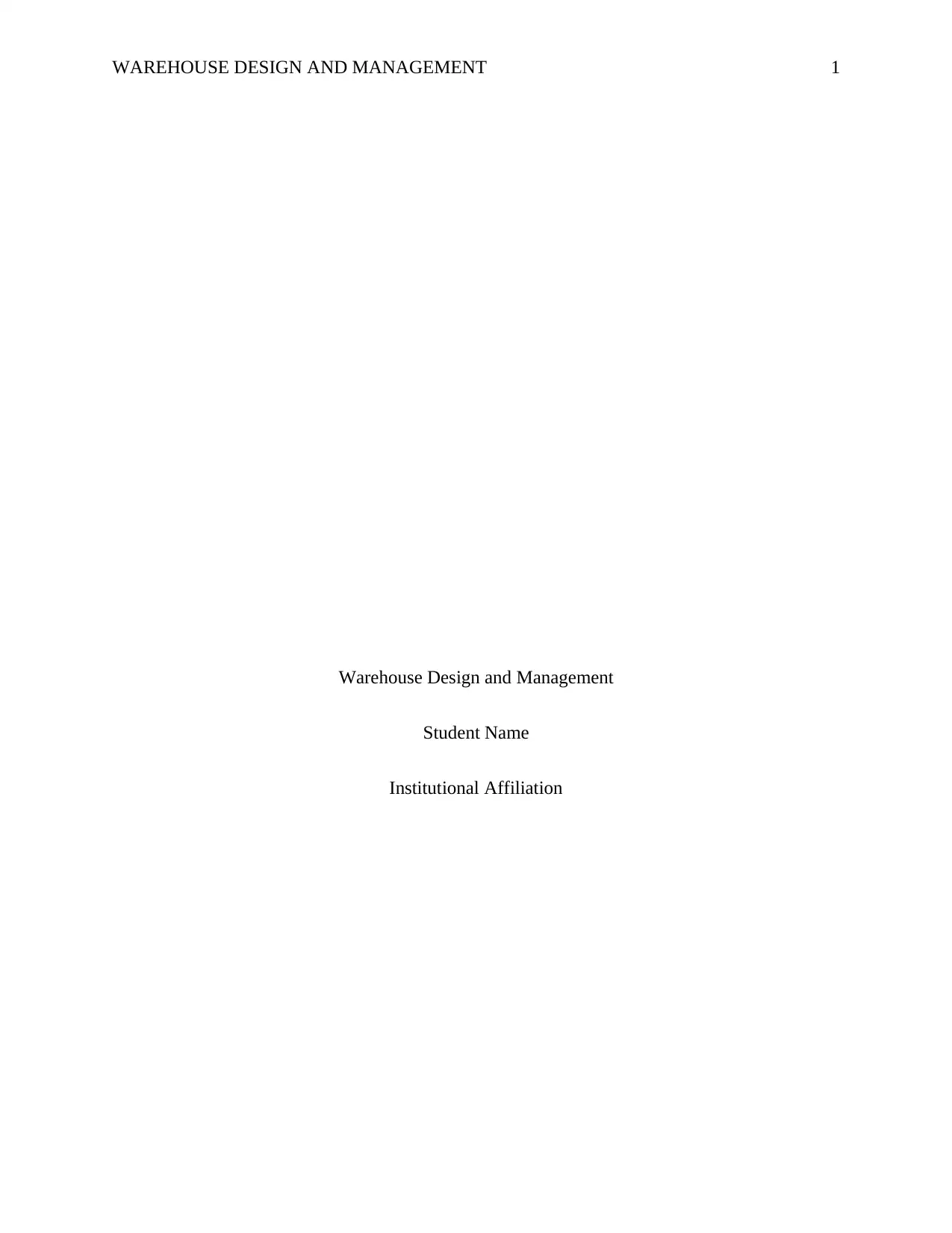
WAREHOUSE DESIGN AND MANAGEMENT 1
Warehouse Design and Management
Student Name
Institutional Affiliation
Warehouse Design and Management
Student Name
Institutional Affiliation
Paraphrase This Document
Need a fresh take? Get an instant paraphrase of this document with our AI Paraphraser
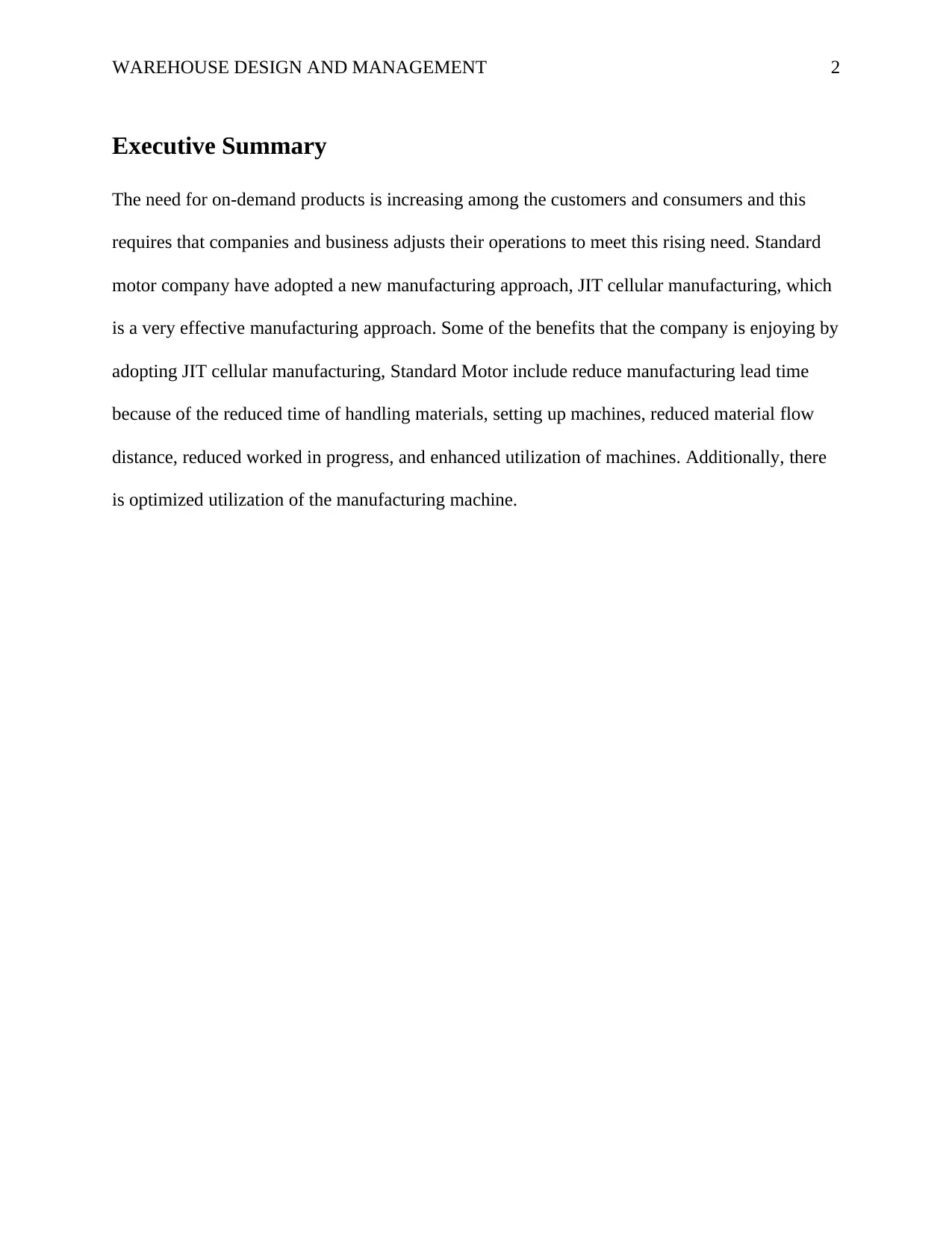
WAREHOUSE DESIGN AND MANAGEMENT 2
Executive Summary
The need for on-demand products is increasing among the customers and consumers and this
requires that companies and business adjusts their operations to meet this rising need. Standard
motor company have adopted a new manufacturing approach, JIT cellular manufacturing, which
is a very effective manufacturing approach. Some of the benefits that the company is enjoying by
adopting JIT cellular manufacturing, Standard Motor include reduce manufacturing lead time
because of the reduced time of handling materials, setting up machines, reduced material flow
distance, reduced worked in progress, and enhanced utilization of machines. Additionally, there
is optimized utilization of the manufacturing machine.
Executive Summary
The need for on-demand products is increasing among the customers and consumers and this
requires that companies and business adjusts their operations to meet this rising need. Standard
motor company have adopted a new manufacturing approach, JIT cellular manufacturing, which
is a very effective manufacturing approach. Some of the benefits that the company is enjoying by
adopting JIT cellular manufacturing, Standard Motor include reduce manufacturing lead time
because of the reduced time of handling materials, setting up machines, reduced material flow
distance, reduced worked in progress, and enhanced utilization of machines. Additionally, there
is optimized utilization of the manufacturing machine.
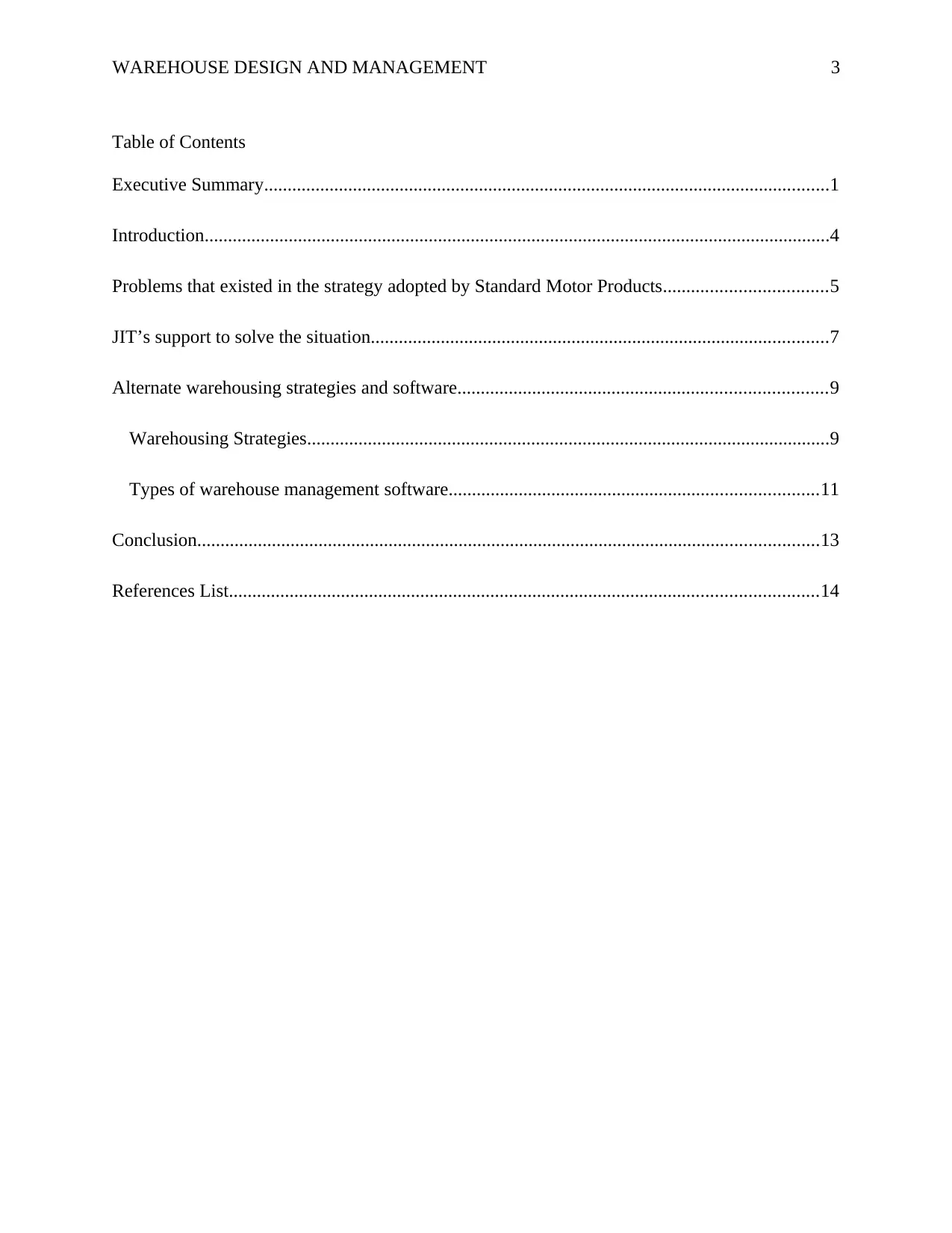
WAREHOUSE DESIGN AND MANAGEMENT 3
Table of Contents
Executive Summary.........................................................................................................................1
Introduction......................................................................................................................................4
Problems that existed in the strategy adopted by Standard Motor Products...................................5
JIT’s support to solve the situation..................................................................................................7
Alternate warehousing strategies and software...............................................................................9
Warehousing Strategies................................................................................................................9
Types of warehouse management software...............................................................................11
Conclusion.....................................................................................................................................13
References List..............................................................................................................................14
Table of Contents
Executive Summary.........................................................................................................................1
Introduction......................................................................................................................................4
Problems that existed in the strategy adopted by Standard Motor Products...................................5
JIT’s support to solve the situation..................................................................................................7
Alternate warehousing strategies and software...............................................................................9
Warehousing Strategies................................................................................................................9
Types of warehouse management software...............................................................................11
Conclusion.....................................................................................................................................13
References List..............................................................................................................................14
⊘ This is a preview!⊘
Do you want full access?
Subscribe today to unlock all pages.

Trusted by 1+ million students worldwide
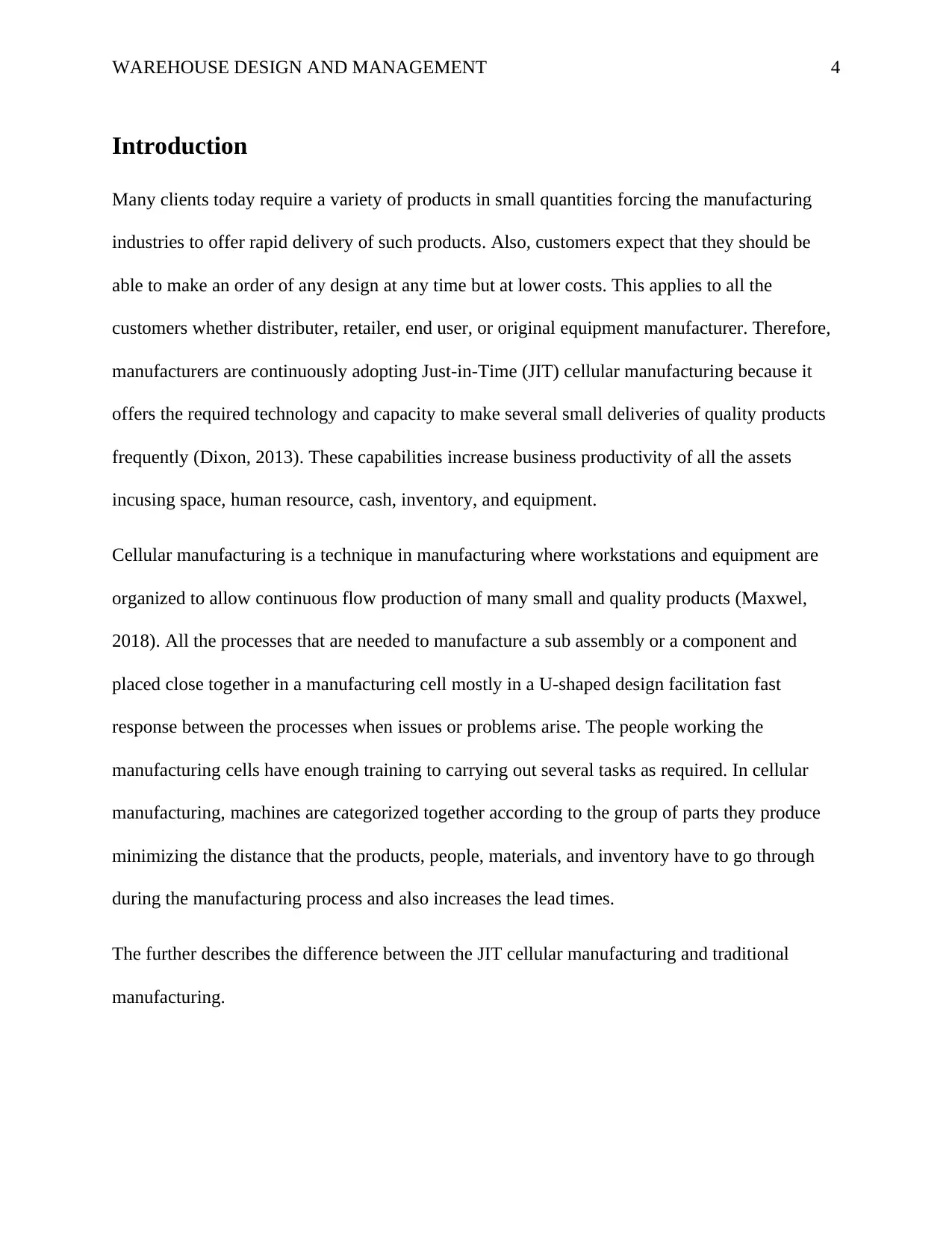
WAREHOUSE DESIGN AND MANAGEMENT 4
Introduction
Many clients today require a variety of products in small quantities forcing the manufacturing
industries to offer rapid delivery of such products. Also, customers expect that they should be
able to make an order of any design at any time but at lower costs. This applies to all the
customers whether distributer, retailer, end user, or original equipment manufacturer. Therefore,
manufacturers are continuously adopting Just-in-Time (JIT) cellular manufacturing because it
offers the required technology and capacity to make several small deliveries of quality products
frequently (Dixon, 2013). These capabilities increase business productivity of all the assets
incusing space, human resource, cash, inventory, and equipment.
Cellular manufacturing is a technique in manufacturing where workstations and equipment are
organized to allow continuous flow production of many small and quality products (Maxwel,
2018). All the processes that are needed to manufacture a sub assembly or a component and
placed close together in a manufacturing cell mostly in a U-shaped design facilitation fast
response between the processes when issues or problems arise. The people working the
manufacturing cells have enough training to carrying out several tasks as required. In cellular
manufacturing, machines are categorized together according to the group of parts they produce
minimizing the distance that the products, people, materials, and inventory have to go through
during the manufacturing process and also increases the lead times.
The further describes the difference between the JIT cellular manufacturing and traditional
manufacturing.
Introduction
Many clients today require a variety of products in small quantities forcing the manufacturing
industries to offer rapid delivery of such products. Also, customers expect that they should be
able to make an order of any design at any time but at lower costs. This applies to all the
customers whether distributer, retailer, end user, or original equipment manufacturer. Therefore,
manufacturers are continuously adopting Just-in-Time (JIT) cellular manufacturing because it
offers the required technology and capacity to make several small deliveries of quality products
frequently (Dixon, 2013). These capabilities increase business productivity of all the assets
incusing space, human resource, cash, inventory, and equipment.
Cellular manufacturing is a technique in manufacturing where workstations and equipment are
organized to allow continuous flow production of many small and quality products (Maxwel,
2018). All the processes that are needed to manufacture a sub assembly or a component and
placed close together in a manufacturing cell mostly in a U-shaped design facilitation fast
response between the processes when issues or problems arise. The people working the
manufacturing cells have enough training to carrying out several tasks as required. In cellular
manufacturing, machines are categorized together according to the group of parts they produce
minimizing the distance that the products, people, materials, and inventory have to go through
during the manufacturing process and also increases the lead times.
The further describes the difference between the JIT cellular manufacturing and traditional
manufacturing.
Paraphrase This Document
Need a fresh take? Get an instant paraphrase of this document with our AI Paraphraser
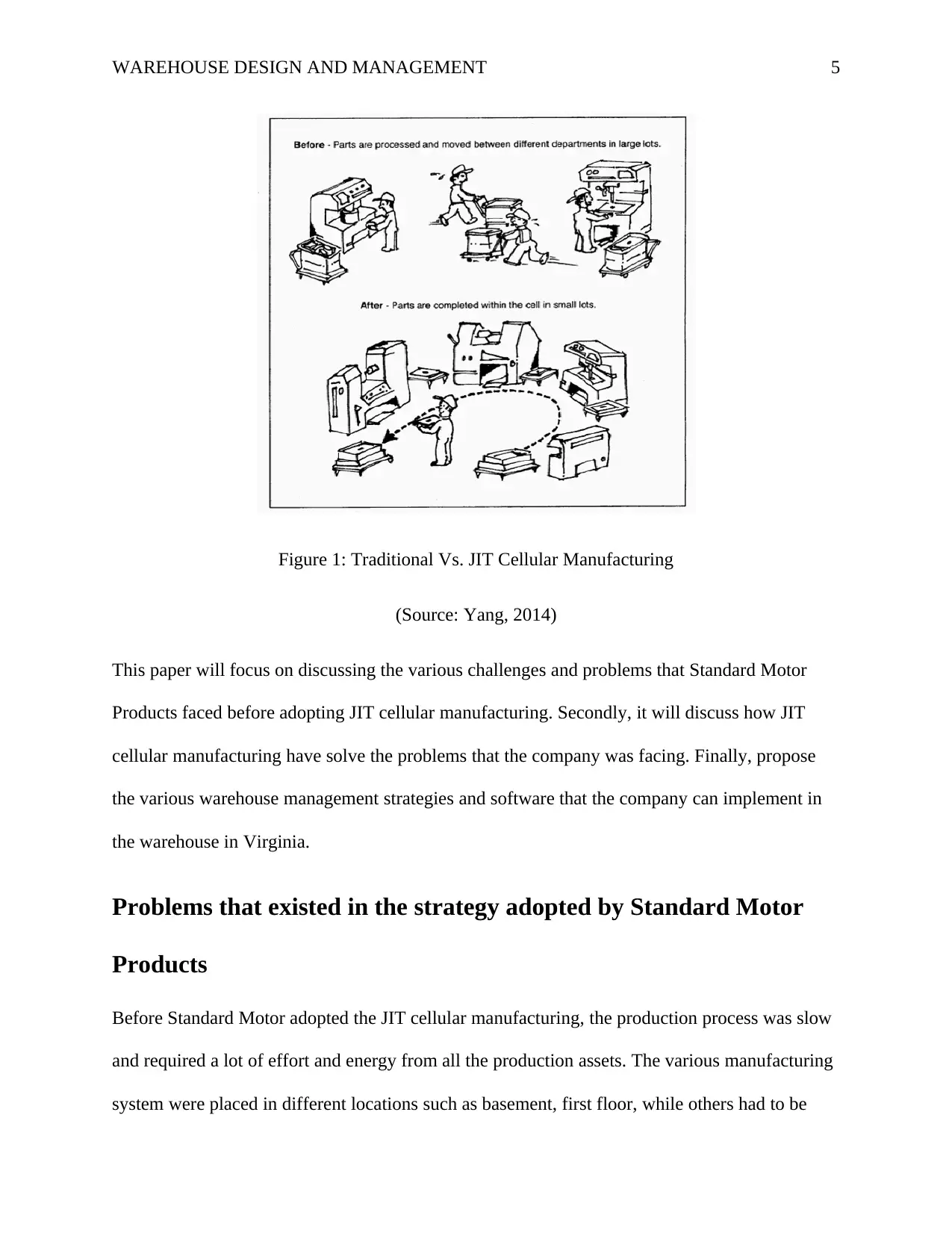
WAREHOUSE DESIGN AND MANAGEMENT 5
Figure 1: Traditional Vs. JIT Cellular Manufacturing
(Source: Yang, 2014)
This paper will focus on discussing the various challenges and problems that Standard Motor
Products faced before adopting JIT cellular manufacturing. Secondly, it will discuss how JIT
cellular manufacturing have solve the problems that the company was facing. Finally, propose
the various warehouse management strategies and software that the company can implement in
the warehouse in Virginia.
Problems that existed in the strategy adopted by Standard Motor
Products
Before Standard Motor adopted the JIT cellular manufacturing, the production process was slow
and required a lot of effort and energy from all the production assets. The various manufacturing
system were placed in different locations such as basement, first floor, while others had to be
Figure 1: Traditional Vs. JIT Cellular Manufacturing
(Source: Yang, 2014)
This paper will focus on discussing the various challenges and problems that Standard Motor
Products faced before adopting JIT cellular manufacturing. Secondly, it will discuss how JIT
cellular manufacturing have solve the problems that the company was facing. Finally, propose
the various warehouse management strategies and software that the company can implement in
the warehouse in Virginia.
Problems that existed in the strategy adopted by Standard Motor
Products
Before Standard Motor adopted the JIT cellular manufacturing, the production process was slow
and required a lot of effort and energy from all the production assets. The various manufacturing
system were placed in different locations such as basement, first floor, while others had to be
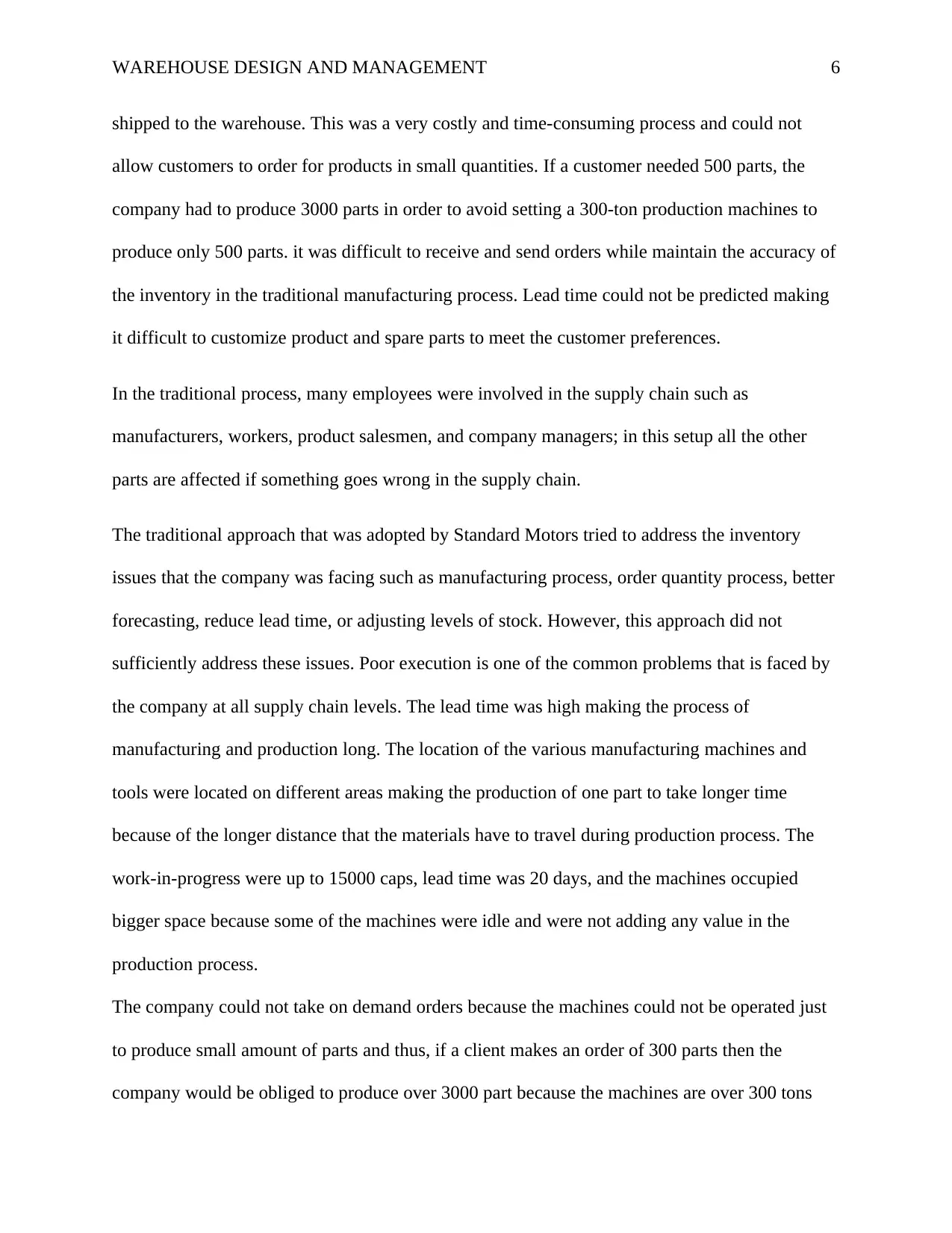
WAREHOUSE DESIGN AND MANAGEMENT 6
shipped to the warehouse. This was a very costly and time-consuming process and could not
allow customers to order for products in small quantities. If a customer needed 500 parts, the
company had to produce 3000 parts in order to avoid setting a 300-ton production machines to
produce only 500 parts. it was difficult to receive and send orders while maintain the accuracy of
the inventory in the traditional manufacturing process. Lead time could not be predicted making
it difficult to customize product and spare parts to meet the customer preferences.
In the traditional process, many employees were involved in the supply chain such as
manufacturers, workers, product salesmen, and company managers; in this setup all the other
parts are affected if something goes wrong in the supply chain.
The traditional approach that was adopted by Standard Motors tried to address the inventory
issues that the company was facing such as manufacturing process, order quantity process, better
forecasting, reduce lead time, or adjusting levels of stock. However, this approach did not
sufficiently address these issues. Poor execution is one of the common problems that is faced by
the company at all supply chain levels. The lead time was high making the process of
manufacturing and production long. The location of the various manufacturing machines and
tools were located on different areas making the production of one part to take longer time
because of the longer distance that the materials have to travel during production process. The
work-in-progress were up to 15000 caps, lead time was 20 days, and the machines occupied
bigger space because some of the machines were idle and were not adding any value in the
production process.
The company could not take on demand orders because the machines could not be operated just
to produce small amount of parts and thus, if a client makes an order of 300 parts then the
company would be obliged to produce over 3000 part because the machines are over 300 tons
shipped to the warehouse. This was a very costly and time-consuming process and could not
allow customers to order for products in small quantities. If a customer needed 500 parts, the
company had to produce 3000 parts in order to avoid setting a 300-ton production machines to
produce only 500 parts. it was difficult to receive and send orders while maintain the accuracy of
the inventory in the traditional manufacturing process. Lead time could not be predicted making
it difficult to customize product and spare parts to meet the customer preferences.
In the traditional process, many employees were involved in the supply chain such as
manufacturers, workers, product salesmen, and company managers; in this setup all the other
parts are affected if something goes wrong in the supply chain.
The traditional approach that was adopted by Standard Motors tried to address the inventory
issues that the company was facing such as manufacturing process, order quantity process, better
forecasting, reduce lead time, or adjusting levels of stock. However, this approach did not
sufficiently address these issues. Poor execution is one of the common problems that is faced by
the company at all supply chain levels. The lead time was high making the process of
manufacturing and production long. The location of the various manufacturing machines and
tools were located on different areas making the production of one part to take longer time
because of the longer distance that the materials have to travel during production process. The
work-in-progress were up to 15000 caps, lead time was 20 days, and the machines occupied
bigger space because some of the machines were idle and were not adding any value in the
production process.
The company could not take on demand orders because the machines could not be operated just
to produce small amount of parts and thus, if a client makes an order of 300 parts then the
company would be obliged to produce over 3000 part because the machines are over 300 tons
⊘ This is a preview!⊘
Do you want full access?
Subscribe today to unlock all pages.

Trusted by 1+ million students worldwide
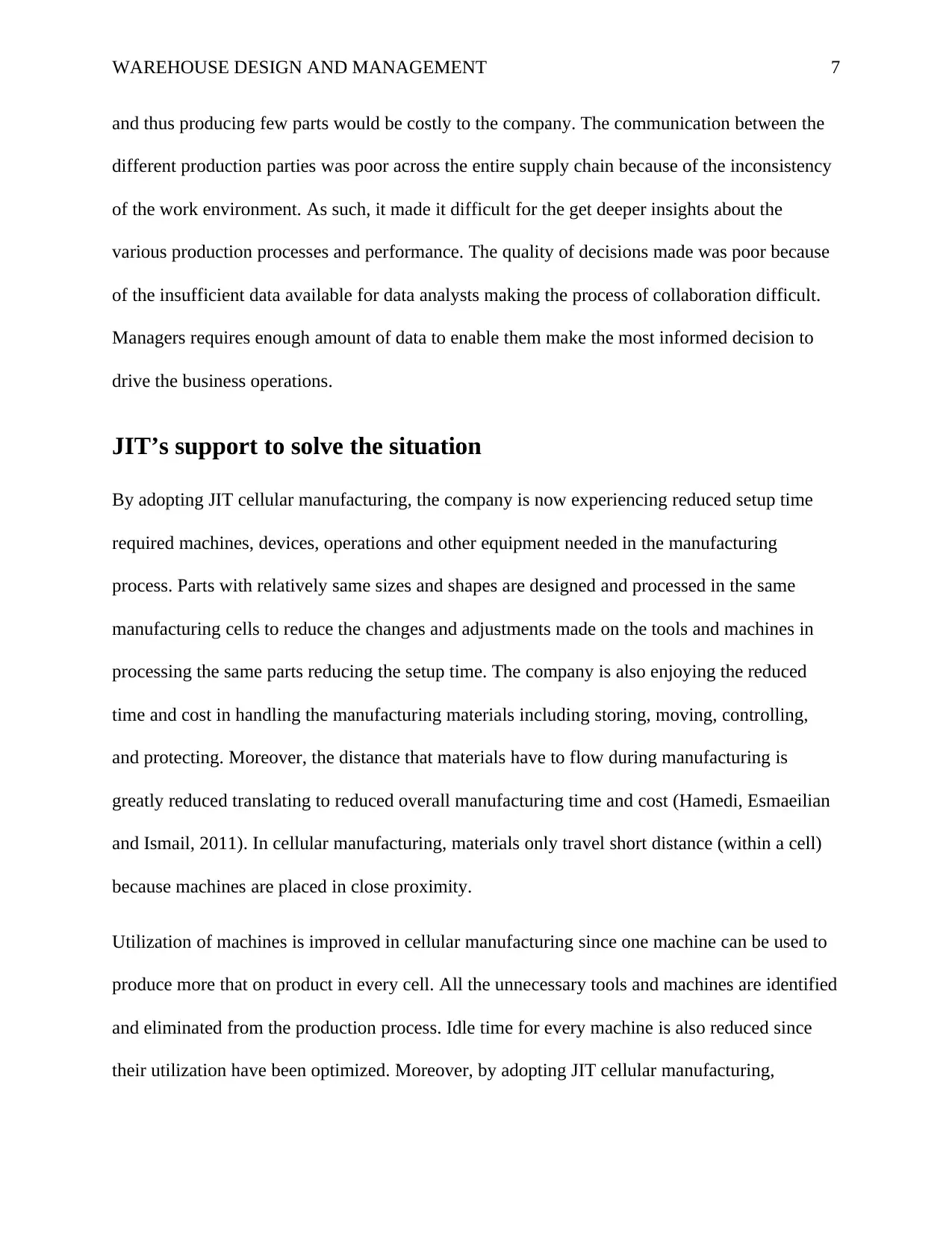
WAREHOUSE DESIGN AND MANAGEMENT 7
and thus producing few parts would be costly to the company. The communication between the
different production parties was poor across the entire supply chain because of the inconsistency
of the work environment. As such, it made it difficult for the get deeper insights about the
various production processes and performance. The quality of decisions made was poor because
of the insufficient data available for data analysts making the process of collaboration difficult.
Managers requires enough amount of data to enable them make the most informed decision to
drive the business operations.
JIT’s support to solve the situation
By adopting JIT cellular manufacturing, the company is now experiencing reduced setup time
required machines, devices, operations and other equipment needed in the manufacturing
process. Parts with relatively same sizes and shapes are designed and processed in the same
manufacturing cells to reduce the changes and adjustments made on the tools and machines in
processing the same parts reducing the setup time. The company is also enjoying the reduced
time and cost in handling the manufacturing materials including storing, moving, controlling,
and protecting. Moreover, the distance that materials have to flow during manufacturing is
greatly reduced translating to reduced overall manufacturing time and cost (Hamedi, Esmaeilian
and Ismail, 2011). In cellular manufacturing, materials only travel short distance (within a cell)
because machines are placed in close proximity.
Utilization of machines is improved in cellular manufacturing since one machine can be used to
produce more that on product in every cell. All the unnecessary tools and machines are identified
and eliminated from the production process. Idle time for every machine is also reduced since
their utilization have been optimized. Moreover, by adopting JIT cellular manufacturing,
and thus producing few parts would be costly to the company. The communication between the
different production parties was poor across the entire supply chain because of the inconsistency
of the work environment. As such, it made it difficult for the get deeper insights about the
various production processes and performance. The quality of decisions made was poor because
of the insufficient data available for data analysts making the process of collaboration difficult.
Managers requires enough amount of data to enable them make the most informed decision to
drive the business operations.
JIT’s support to solve the situation
By adopting JIT cellular manufacturing, the company is now experiencing reduced setup time
required machines, devices, operations and other equipment needed in the manufacturing
process. Parts with relatively same sizes and shapes are designed and processed in the same
manufacturing cells to reduce the changes and adjustments made on the tools and machines in
processing the same parts reducing the setup time. The company is also enjoying the reduced
time and cost in handling the manufacturing materials including storing, moving, controlling,
and protecting. Moreover, the distance that materials have to flow during manufacturing is
greatly reduced translating to reduced overall manufacturing time and cost (Hamedi, Esmaeilian
and Ismail, 2011). In cellular manufacturing, materials only travel short distance (within a cell)
because machines are placed in close proximity.
Utilization of machines is improved in cellular manufacturing since one machine can be used to
produce more that on product in every cell. All the unnecessary tools and machines are identified
and eliminated from the production process. Idle time for every machine is also reduced since
their utilization have been optimized. Moreover, by adopting JIT cellular manufacturing,
Paraphrase This Document
Need a fresh take? Get an instant paraphrase of this document with our AI Paraphraser
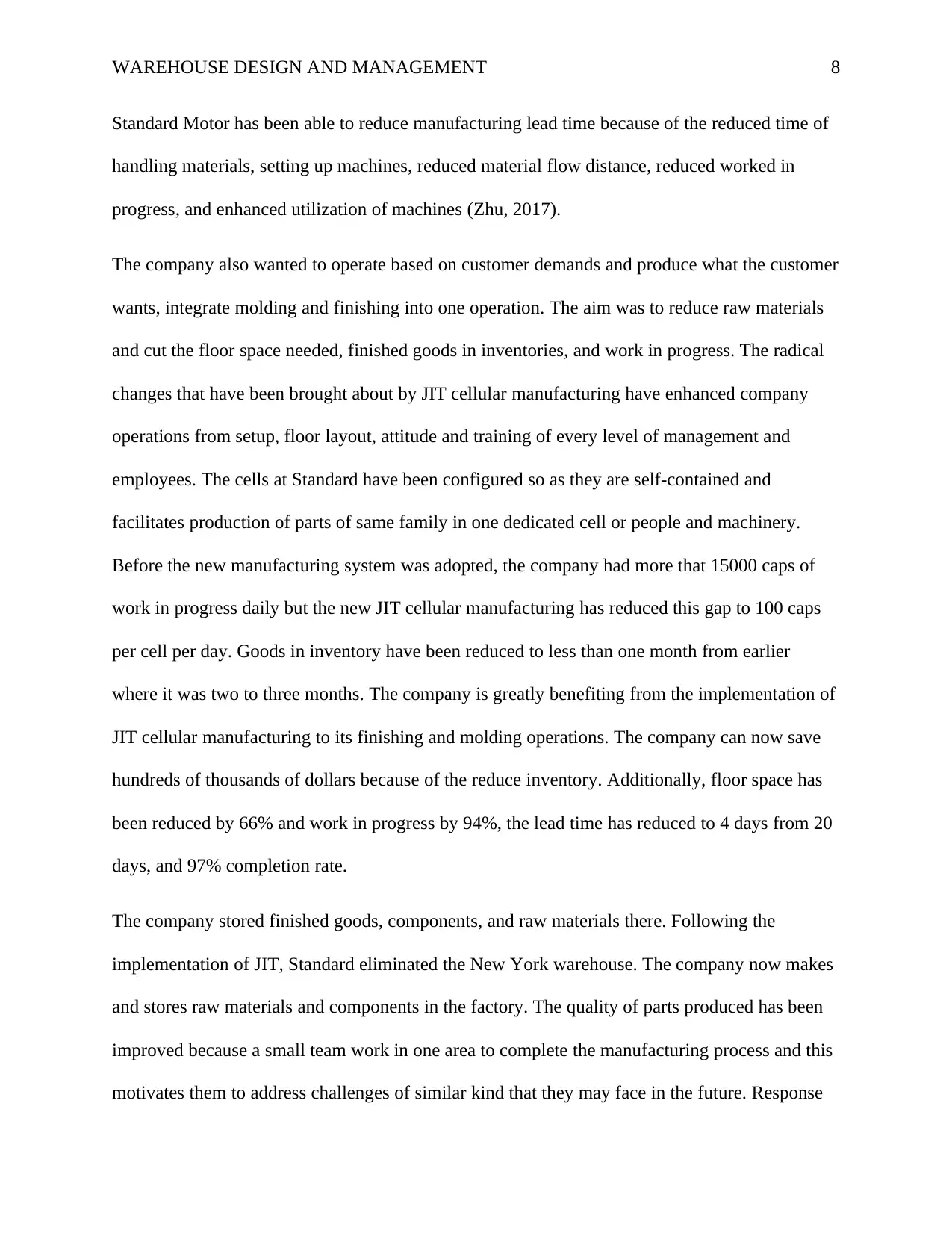
WAREHOUSE DESIGN AND MANAGEMENT 8
Standard Motor has been able to reduce manufacturing lead time because of the reduced time of
handling materials, setting up machines, reduced material flow distance, reduced worked in
progress, and enhanced utilization of machines (Zhu, 2017).
The company also wanted to operate based on customer demands and produce what the customer
wants, integrate molding and finishing into one operation. The aim was to reduce raw materials
and cut the floor space needed, finished goods in inventories, and work in progress. The radical
changes that have been brought about by JIT cellular manufacturing have enhanced company
operations from setup, floor layout, attitude and training of every level of management and
employees. The cells at Standard have been configured so as they are self-contained and
facilitates production of parts of same family in one dedicated cell or people and machinery.
Before the new manufacturing system was adopted, the company had more that 15000 caps of
work in progress daily but the new JIT cellular manufacturing has reduced this gap to 100 caps
per cell per day. Goods in inventory have been reduced to less than one month from earlier
where it was two to three months. The company is greatly benefiting from the implementation of
JIT cellular manufacturing to its finishing and molding operations. The company can now save
hundreds of thousands of dollars because of the reduce inventory. Additionally, floor space has
been reduced by 66% and work in progress by 94%, the lead time has reduced to 4 days from 20
days, and 97% completion rate.
The company stored finished goods, components, and raw materials there. Following the
implementation of JIT, Standard eliminated the New York warehouse. The company now makes
and stores raw materials and components in the factory. The quality of parts produced has been
improved because a small team work in one area to complete the manufacturing process and this
motivates them to address challenges of similar kind that they may face in the future. Response
Standard Motor has been able to reduce manufacturing lead time because of the reduced time of
handling materials, setting up machines, reduced material flow distance, reduced worked in
progress, and enhanced utilization of machines (Zhu, 2017).
The company also wanted to operate based on customer demands and produce what the customer
wants, integrate molding and finishing into one operation. The aim was to reduce raw materials
and cut the floor space needed, finished goods in inventories, and work in progress. The radical
changes that have been brought about by JIT cellular manufacturing have enhanced company
operations from setup, floor layout, attitude and training of every level of management and
employees. The cells at Standard have been configured so as they are self-contained and
facilitates production of parts of same family in one dedicated cell or people and machinery.
Before the new manufacturing system was adopted, the company had more that 15000 caps of
work in progress daily but the new JIT cellular manufacturing has reduced this gap to 100 caps
per cell per day. Goods in inventory have been reduced to less than one month from earlier
where it was two to three months. The company is greatly benefiting from the implementation of
JIT cellular manufacturing to its finishing and molding operations. The company can now save
hundreds of thousands of dollars because of the reduce inventory. Additionally, floor space has
been reduced by 66% and work in progress by 94%, the lead time has reduced to 4 days from 20
days, and 97% completion rate.
The company stored finished goods, components, and raw materials there. Following the
implementation of JIT, Standard eliminated the New York warehouse. The company now makes
and stores raw materials and components in the factory. The quality of parts produced has been
improved because a small team work in one area to complete the manufacturing process and this
motivates them to address challenges of similar kind that they may face in the future. Response
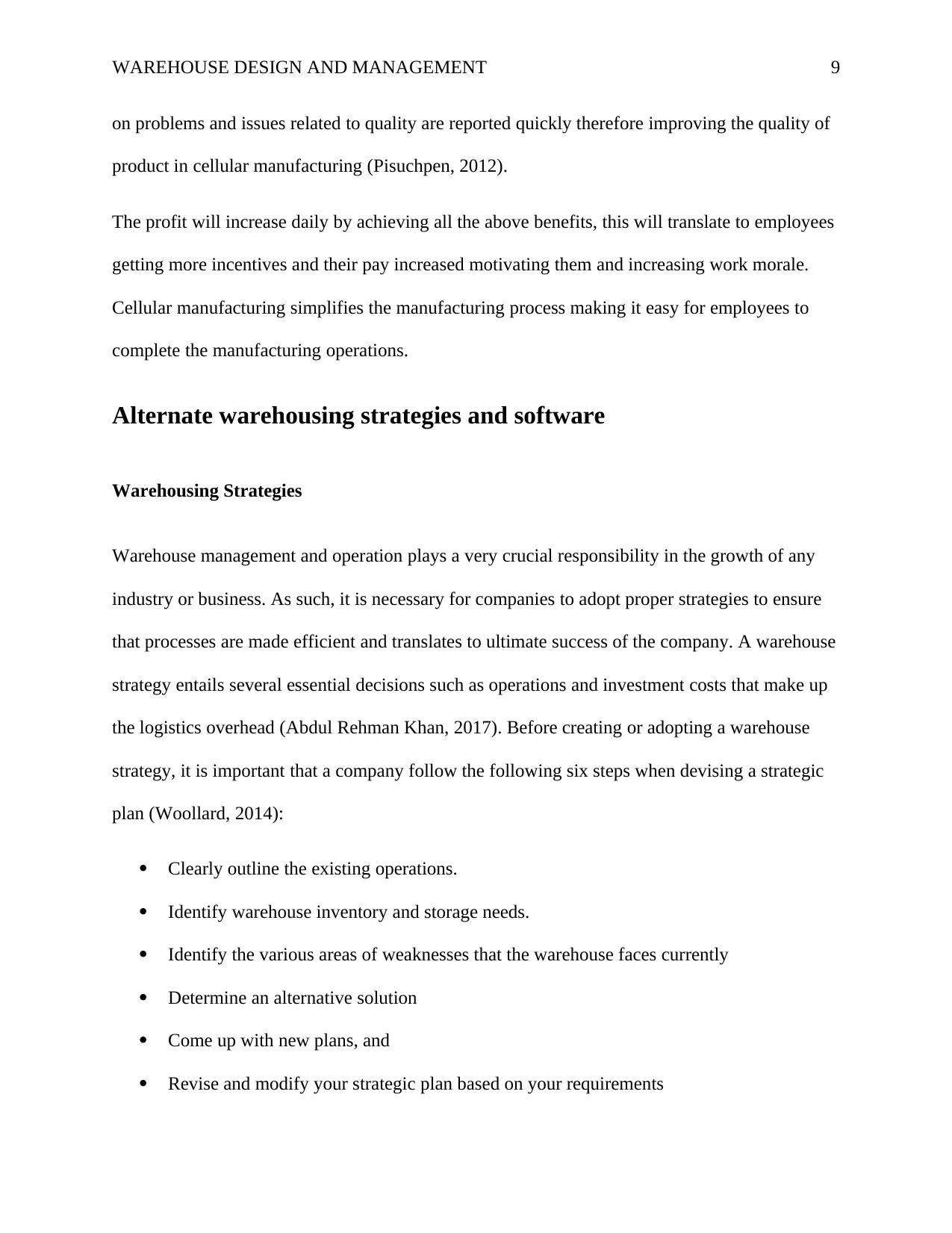
WAREHOUSE DESIGN AND MANAGEMENT 9
on problems and issues related to quality are reported quickly therefore improving the quality of
product in cellular manufacturing (Pisuchpen, 2012).
The profit will increase daily by achieving all the above benefits, this will translate to employees
getting more incentives and their pay increased motivating them and increasing work morale.
Cellular manufacturing simplifies the manufacturing process making it easy for employees to
complete the manufacturing operations.
Alternate warehousing strategies and software
Warehousing Strategies
Warehouse management and operation plays a very crucial responsibility in the growth of any
industry or business. As such, it is necessary for companies to adopt proper strategies to ensure
that processes are made efficient and translates to ultimate success of the company. A warehouse
strategy entails several essential decisions such as operations and investment costs that make up
the logistics overhead (Abdul Rehman Khan, 2017). Before creating or adopting a warehouse
strategy, it is important that a company follow the following six steps when devising a strategic
plan (Woollard, 2014):
Clearly outline the existing operations.
Identify warehouse inventory and storage needs.
Identify the various areas of weaknesses that the warehouse faces currently
Determine an alternative solution
Come up with new plans, and
Revise and modify your strategic plan based on your requirements
on problems and issues related to quality are reported quickly therefore improving the quality of
product in cellular manufacturing (Pisuchpen, 2012).
The profit will increase daily by achieving all the above benefits, this will translate to employees
getting more incentives and their pay increased motivating them and increasing work morale.
Cellular manufacturing simplifies the manufacturing process making it easy for employees to
complete the manufacturing operations.
Alternate warehousing strategies and software
Warehousing Strategies
Warehouse management and operation plays a very crucial responsibility in the growth of any
industry or business. As such, it is necessary for companies to adopt proper strategies to ensure
that processes are made efficient and translates to ultimate success of the company. A warehouse
strategy entails several essential decisions such as operations and investment costs that make up
the logistics overhead (Abdul Rehman Khan, 2017). Before creating or adopting a warehouse
strategy, it is important that a company follow the following six steps when devising a strategic
plan (Woollard, 2014):
Clearly outline the existing operations.
Identify warehouse inventory and storage needs.
Identify the various areas of weaknesses that the warehouse faces currently
Determine an alternative solution
Come up with new plans, and
Revise and modify your strategic plan based on your requirements
⊘ This is a preview!⊘
Do you want full access?
Subscribe today to unlock all pages.

Trusted by 1+ million students worldwide
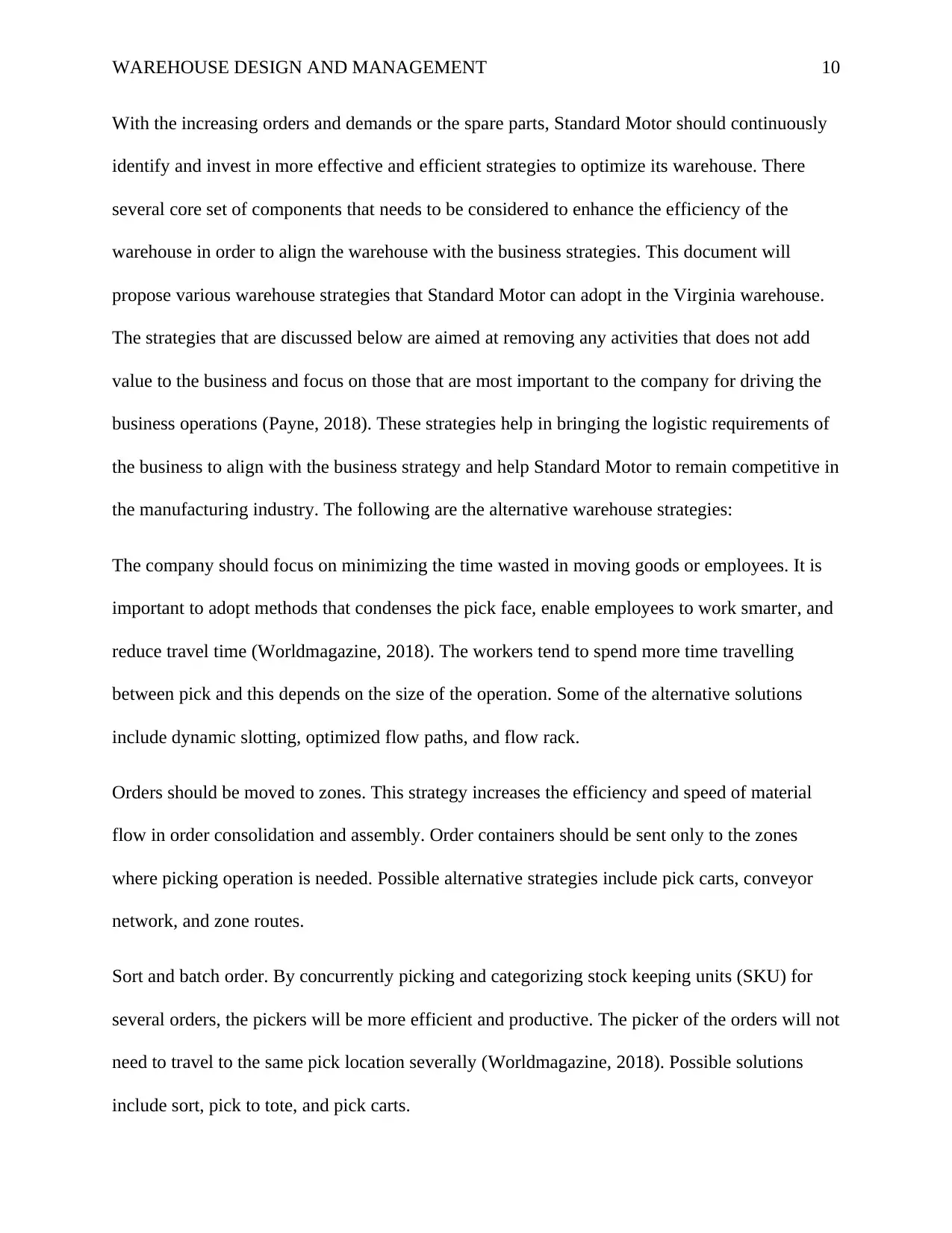
WAREHOUSE DESIGN AND MANAGEMENT 10
With the increasing orders and demands or the spare parts, Standard Motor should continuously
identify and invest in more effective and efficient strategies to optimize its warehouse. There
several core set of components that needs to be considered to enhance the efficiency of the
warehouse in order to align the warehouse with the business strategies. This document will
propose various warehouse strategies that Standard Motor can adopt in the Virginia warehouse.
The strategies that are discussed below are aimed at removing any activities that does not add
value to the business and focus on those that are most important to the company for driving the
business operations (Payne, 2018). These strategies help in bringing the logistic requirements of
the business to align with the business strategy and help Standard Motor to remain competitive in
the manufacturing industry. The following are the alternative warehouse strategies:
The company should focus on minimizing the time wasted in moving goods or employees. It is
important to adopt methods that condenses the pick face, enable employees to work smarter, and
reduce travel time (Worldmagazine, 2018). The workers tend to spend more time travelling
between pick and this depends on the size of the operation. Some of the alternative solutions
include dynamic slotting, optimized flow paths, and flow rack.
Orders should be moved to zones. This strategy increases the efficiency and speed of material
flow in order consolidation and assembly. Order containers should be sent only to the zones
where picking operation is needed. Possible alternative strategies include pick carts, conveyor
network, and zone routes.
Sort and batch order. By concurrently picking and categorizing stock keeping units (SKU) for
several orders, the pickers will be more efficient and productive. The picker of the orders will not
need to travel to the same pick location severally (Worldmagazine, 2018). Possible solutions
include sort, pick to tote, and pick carts.
With the increasing orders and demands or the spare parts, Standard Motor should continuously
identify and invest in more effective and efficient strategies to optimize its warehouse. There
several core set of components that needs to be considered to enhance the efficiency of the
warehouse in order to align the warehouse with the business strategies. This document will
propose various warehouse strategies that Standard Motor can adopt in the Virginia warehouse.
The strategies that are discussed below are aimed at removing any activities that does not add
value to the business and focus on those that are most important to the company for driving the
business operations (Payne, 2018). These strategies help in bringing the logistic requirements of
the business to align with the business strategy and help Standard Motor to remain competitive in
the manufacturing industry. The following are the alternative warehouse strategies:
The company should focus on minimizing the time wasted in moving goods or employees. It is
important to adopt methods that condenses the pick face, enable employees to work smarter, and
reduce travel time (Worldmagazine, 2018). The workers tend to spend more time travelling
between pick and this depends on the size of the operation. Some of the alternative solutions
include dynamic slotting, optimized flow paths, and flow rack.
Orders should be moved to zones. This strategy increases the efficiency and speed of material
flow in order consolidation and assembly. Order containers should be sent only to the zones
where picking operation is needed. Possible alternative strategies include pick carts, conveyor
network, and zone routes.
Sort and batch order. By concurrently picking and categorizing stock keeping units (SKU) for
several orders, the pickers will be more efficient and productive. The picker of the orders will not
need to travel to the same pick location severally (Worldmagazine, 2018). Possible solutions
include sort, pick to tote, and pick carts.
Paraphrase This Document
Need a fresh take? Get an instant paraphrase of this document with our AI Paraphraser
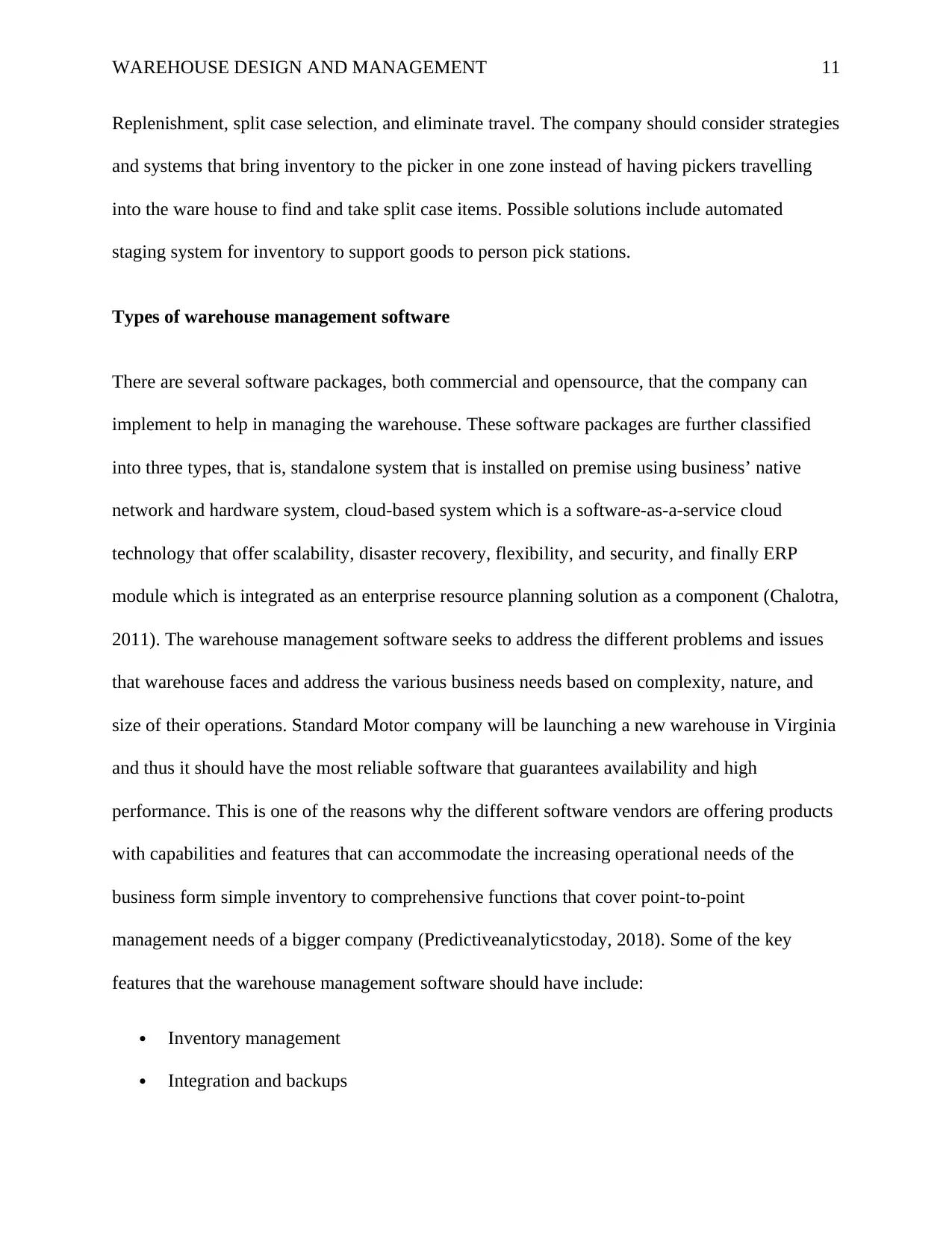
WAREHOUSE DESIGN AND MANAGEMENT 11
Replenishment, split case selection, and eliminate travel. The company should consider strategies
and systems that bring inventory to the picker in one zone instead of having pickers travelling
into the ware house to find and take split case items. Possible solutions include automated
staging system for inventory to support goods to person pick stations.
Types of warehouse management software
There are several software packages, both commercial and opensource, that the company can
implement to help in managing the warehouse. These software packages are further classified
into three types, that is, standalone system that is installed on premise using business’ native
network and hardware system, cloud-based system which is a software-as-a-service cloud
technology that offer scalability, disaster recovery, flexibility, and security, and finally ERP
module which is integrated as an enterprise resource planning solution as a component (Chalotra,
2011). The warehouse management software seeks to address the different problems and issues
that warehouse faces and address the various business needs based on complexity, nature, and
size of their operations. Standard Motor company will be launching a new warehouse in Virginia
and thus it should have the most reliable software that guarantees availability and high
performance. This is one of the reasons why the different software vendors are offering products
with capabilities and features that can accommodate the increasing operational needs of the
business form simple inventory to comprehensive functions that cover point-to-point
management needs of a bigger company (Predictiveanalyticstoday, 2018). Some of the key
features that the warehouse management software should have include:
Inventory management
Integration and backups
Replenishment, split case selection, and eliminate travel. The company should consider strategies
and systems that bring inventory to the picker in one zone instead of having pickers travelling
into the ware house to find and take split case items. Possible solutions include automated
staging system for inventory to support goods to person pick stations.
Types of warehouse management software
There are several software packages, both commercial and opensource, that the company can
implement to help in managing the warehouse. These software packages are further classified
into three types, that is, standalone system that is installed on premise using business’ native
network and hardware system, cloud-based system which is a software-as-a-service cloud
technology that offer scalability, disaster recovery, flexibility, and security, and finally ERP
module which is integrated as an enterprise resource planning solution as a component (Chalotra,
2011). The warehouse management software seeks to address the different problems and issues
that warehouse faces and address the various business needs based on complexity, nature, and
size of their operations. Standard Motor company will be launching a new warehouse in Virginia
and thus it should have the most reliable software that guarantees availability and high
performance. This is one of the reasons why the different software vendors are offering products
with capabilities and features that can accommodate the increasing operational needs of the
business form simple inventory to comprehensive functions that cover point-to-point
management needs of a bigger company (Predictiveanalyticstoday, 2018). Some of the key
features that the warehouse management software should have include:
Inventory management
Integration and backups
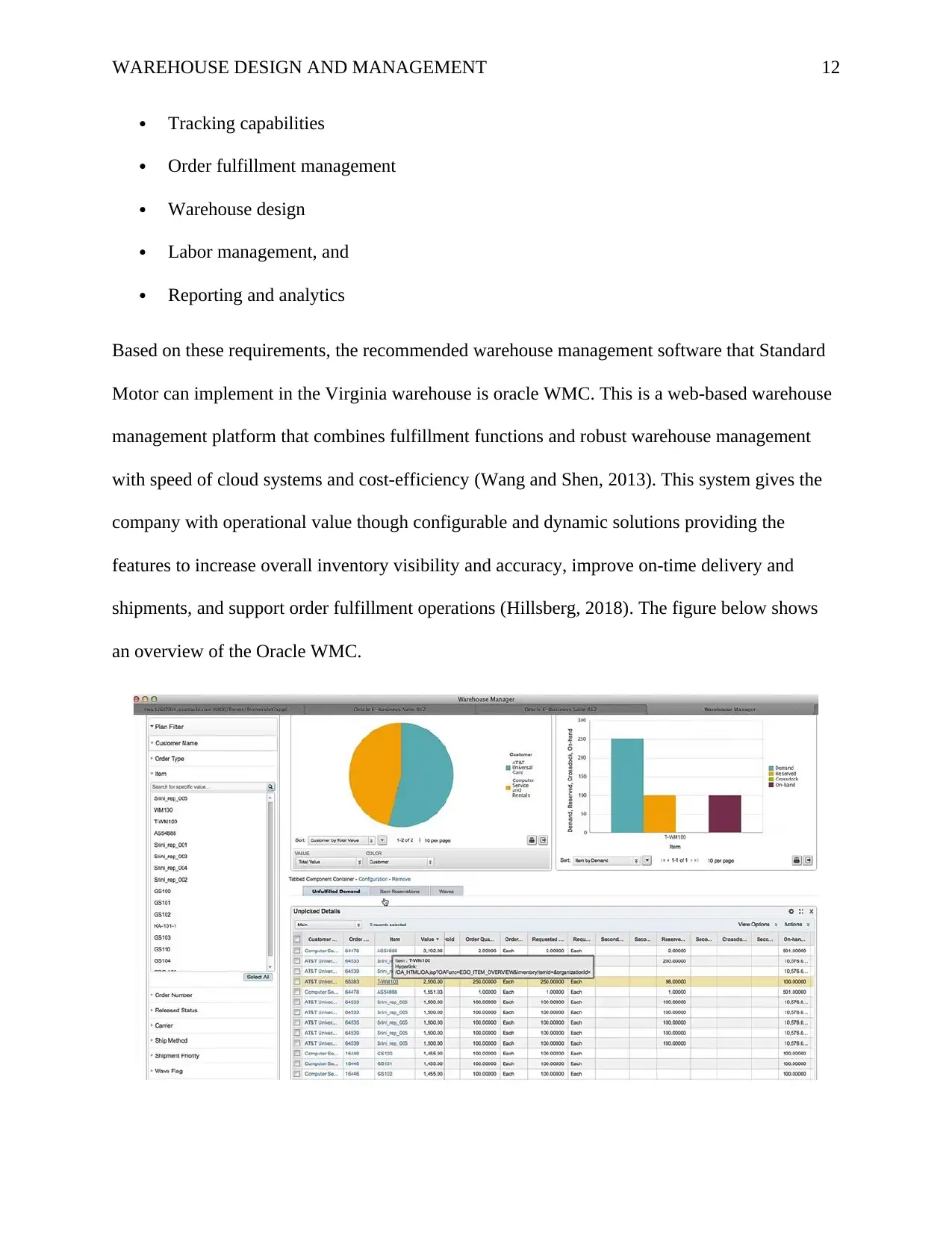
WAREHOUSE DESIGN AND MANAGEMENT 12
Tracking capabilities
Order fulfillment management
Warehouse design
Labor management, and
Reporting and analytics
Based on these requirements, the recommended warehouse management software that Standard
Motor can implement in the Virginia warehouse is oracle WMC. This is a web-based warehouse
management platform that combines fulfillment functions and robust warehouse management
with speed of cloud systems and cost-efficiency (Wang and Shen, 2013). This system gives the
company with operational value though configurable and dynamic solutions providing the
features to increase overall inventory visibility and accuracy, improve on-time delivery and
shipments, and support order fulfillment operations (Hillsberg, 2018). The figure below shows
an overview of the Oracle WMC.
Tracking capabilities
Order fulfillment management
Warehouse design
Labor management, and
Reporting and analytics
Based on these requirements, the recommended warehouse management software that Standard
Motor can implement in the Virginia warehouse is oracle WMC. This is a web-based warehouse
management platform that combines fulfillment functions and robust warehouse management
with speed of cloud systems and cost-efficiency (Wang and Shen, 2013). This system gives the
company with operational value though configurable and dynamic solutions providing the
features to increase overall inventory visibility and accuracy, improve on-time delivery and
shipments, and support order fulfillment operations (Hillsberg, 2018). The figure below shows
an overview of the Oracle WMC.
⊘ This is a preview!⊘
Do you want full access?
Subscribe today to unlock all pages.

Trusted by 1+ million students worldwide
1 out of 16
Related Documents
Your All-in-One AI-Powered Toolkit for Academic Success.
+13062052269
info@desklib.com
Available 24*7 on WhatsApp / Email
![[object Object]](/_next/static/media/star-bottom.7253800d.svg)
Unlock your academic potential
Copyright © 2020–2025 A2Z Services. All Rights Reserved. Developed and managed by ZUCOL.





